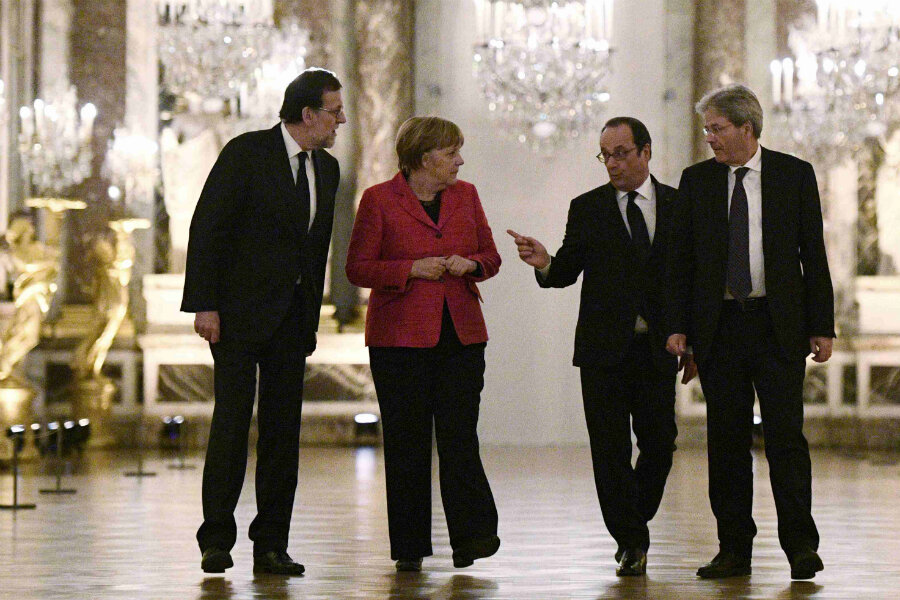What does ‘multispeed’ Europe really mean?
Loading...
The Treaty of Rome, which gave rise to the European Union, is marking its 60th anniversary. But at this milestone, the EU finds itself deep in existential crisis. One idea to boost the postwar project is the notion of a “multispeed” Europe.
Q: What is a multispeed Europe?
In theory the idea is simple. It would allow some of the 27 members of the bloc (after Britain chose to leave last year) to opt in to various policies and others to opt out. This idea, which is not new, got new life ahead of an EU summit in Rome March 25, where leaders were expected to sign a declaration on the future of Europe post-“Brexit.” In a white paper ahead of the summit, multispeed Europe was one of five scenarios proposed by EU Commission President Jean-Claude Juncker. He envisioned, in this scenario, “coalitions of the willing” that could move toward deeper integration on everything from defense and international security to social programs.
No concrete policies were listed in the white paper, but it included various examples of how a multispeed Europe might function in practice. One such example had to do with internet-connected cars: “Connected cars are widely used in the 12 Member States that have agreed to harmonise their rules and standards,” the paper says. In another scenario, six countries acquire a drone. “This can be used for sea and land surveillance, as well as in humanitarian rescue operations,” the paper says. “A joint defence programme is set up to protect critical infrastructure against cyber-attacks.”
Q: What is this idea meant to solve?
Above all, a crisis of confidence. Still emerging from the aftershocks of the financial crisis, the EU has been dealt a series of other challenges in recent years. As Europeans have faced Brexit, a brand of populism that feeds on Euroskepticism, and fears of terrorism and security weaknesses, they’ve increasingly questioned the viability of the postwar project. At the same time, squabbling over how to solve the problems – such as the record refugee flows in 2015 – has hindered Europe’s ability to respond robustly, further undermining citizen confidence.
Still, opinion surveys show that support for the project is more positive than media outlets reflect. More than two-thirds of Europeans see the EU as a place of stability, and more than 80 percent support its four founding freedoms (free movement of goods, services, people, and capital). However, only a third of citizens trust it today, down from half a decade ago, according to the EU Commission’s white paper. Leaders fear that if they don’t change direction, perceptions could continue on a downward trajectory.
Q: Who’s for and against it?
The founding members of the EU, notably France and Germany, have pushed a multispeed Europe as the way forward. French President François Hollande gathered the leaders of Germany, Italy, and Spain for a “mini summit” at Versailles earlier this month to rally around the idea. “For a long time this idea of a differentiated Europe, with different speeds and different rates of integration, has provoked a lot of resistance. But today, it is a necessary idea. Otherwise, Europe will explode,” said Mr. Hollande, according to Euractiv.
But countries in the East, notably Poland, have been vocally opposed. Recently Polish Prime Minister Beata Szydło said she’d “never agree” to such a plan. Many smaller countries that joined the EU only in 2004 are sensitive about being overshadowed by the core founding members in Western Europe. A multispeed policy, they worry, could institutionalize these imbalances.
Q: How likely is it to work?
In practice, a multispeed Europe already operates. Nineteen states use the euro, for example. Not all EU countries participate in the passport-free travel area. Yet leaders have been forced to defend the idea, reining in ambitions. And Mr. Juncker tried to allay concerns, saying a differentiated Europe would not create a “new iron curtain.”
Tellingly, a draft of the Rome declaration put online by Politico leaves out any mention of the contentious word “multispeed.” Instead, it states that the bloc will “work together to promote the common good, on the understanding that some of us can move closer, further and faster in some areas, keeping the door open to those who want to join later....” It promotes an “undivided and indivisible Union, which acts together whenever possible, at different paces and intensity whenever necessary.”
Still, the fact that German Chancellor Angela Merkel, as the de facto leader of Europe, has put her weight behind it means that even if it’s not officially called a “multispeed” Europe, the EU might start acting like one. “The motto is that we are united in diversity,” Ms. Merkel said about the declaration on Europe’s future.
After all, the stakes are high: Russia and the United States, under President Trump, have been shaking up Europe’s postwar assumptions.








